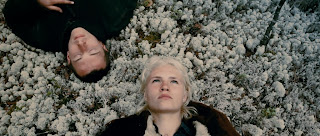ATHENS 26th Panorama of European Cinema:
THE SEA (More) by Alexandra Strelyanaya
awarded Best Film
Beyond
the Sea...
How
long does summer last up North? How long does a summer ardour last? How could
we know when an encounter portends the ultimate truth in the economy of our lives,
or just a necessary passing?
Between
the barren land and the gradually insensitive sea, Alexandra Strelyanaya’s ‘The
Sea’ ( More) is a lyrical journey throughout the wilderness of Northern Russia and it follows two young people.
They
meet on the Kola Peninsula. He comes from the one-dimensional advertising
Moscow world and is a youthful photographer. When sent on a project to the North Sea coast,
he encounters a sunny young woman. She
will become his guide all the way through the isolated fisherman’s village at
the coast… They will eventually fall
in love, influenced largely by a landscape that fits their ideal of love,
surrounded by beauty and cinema.
The film was shot in 27 days in
the autumn of 2012 with low budget, and Strelyanaya wrote the script and was
also the DOP. This piece, that often converges to the boundaries of conceptual
art, has superb framing, convincing actors (Taisia Krammi and Ilya Rigin) and revealing interviews. And
over all, a few black and white amateur like videos,
intensely intriguing...
The stirring atmosphere of those remote
places, captivatingly shot and edited, offers the viewer a mysterious journey
to the harsh landscape of a desolated settlement and to its veiled
secrets.
There live mostly older people and we watch in oath their struggle with the sea.
The Sea as the main character of both fiction and reality, a sea that appoints the rhythm of their lives.
There live mostly older people and we watch in oath their struggle with the sea.
The Sea as the main character of both fiction and reality, a sea that appoints the rhythm of their lives.
Alexandra
Strelyanaya combines here doccumentary and
love story, on the ideea that both local customs and love fade in time...
When in
Moscow studying Image, the photgrapher had always fantasized of the Sea, of its
supremacy, of its deadly appeal, of that particular kind of energy that gives,
and takes away...
Summertime
sees him abandoning the shalowness of the big bad city and taking a
regenerating trip for breathing inn the Sea flavor...
Doccumenting
Kola’s people’ secular life is the official pretexte for a travel into his own
interior landscape.
The director is not proposing an even
storyline. Yet she fruitfully portrays
the atmosphere of a disappearing world, living by an endless and windswept sea.
She is sharing with us this thrilling, yet painful cruelty of their life, but
also its exquisiteness. A Beauty that comes from a land and a Sea that engender
less and less life…Fish is now scarce in those ominous waters, and the wild
forests that once were shelter and hunting grounds have now completely
disappeared. Green dark soft lichen has now invaded all the soil, a sort of
harmonious, yet menacing response to the dark green of the motionless sea…
It is a film that
at first view appears as spontaneous and improvised as the love encounter we
are watching, but which in fact it has been attentively developed. Just like the
levels of intimacy to which the cameraman agrees, gradually, as he is always in
control,always watching reality through his camera’ lenses, continously keeping
the distance of a passer by and of a creator...
In those
lifeless lands, nothing and no-one is born anymore. Nothing but this love, a
love that oscilates between the playfullness of the wind, the unwrapping of the
infinite land, and the restraint of the Sea...
The
photgrapher records the savage beauty of this slowly desappearing world through elegiac images.
Ever more enthused
by the landscape he sees, his relationship with the local girl is immediately
intense. They are accomplices in art, she helps him finding old homemade
footage of deceased inhabitants and of their habits, and convinces other locals
to be interviewed.
The girl
at some point asks the dreamy cameraman (her lover), when he starts again a
take: “...Are we shooting the film now, or is it just real life”...It is
precisely in this alternace of styles of repeated takes, of dissimilar rythms, of dialogues and silence,
that lays the grand splendor of this film.
Beyond the combination of actual interviews
with the local population, and of fiction parts, we see how the relationship
between the two becomes deeper, complicated, and twists into a (summer?) love
affair. Will he come back? Does he love her? The girl wants more, the girl
wants answers, she wants Love, Life, as opposed to the Death that continuously dwells
in that hushed Sea.
He answers by unmitigated silence, and the
director tells it all with a final very long take that pans from a helicopter
all that shore…It is a pan above the houses, the hearts and souls and spirit
and dreams of people who miraculously survive in a peculiar area, midway
between affection and abhorrence, amid life and death …
Giulia Dobre is a Film Critic at the Romanian
National Radio and a Visual Anthropologist at ENSAD-Paris.












No comments:
Post a Comment